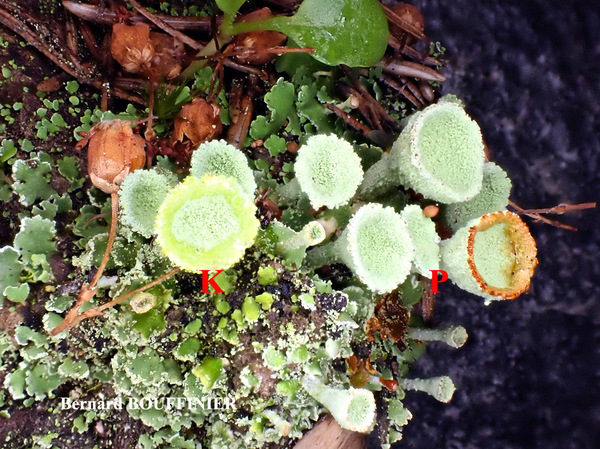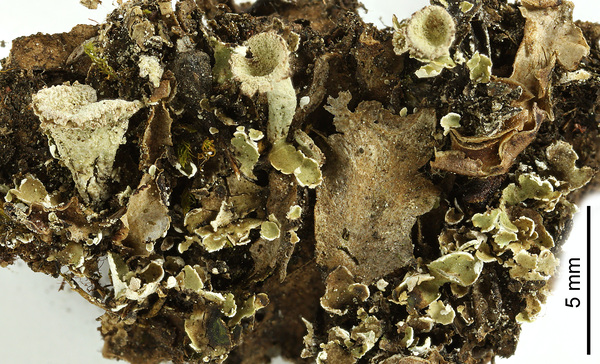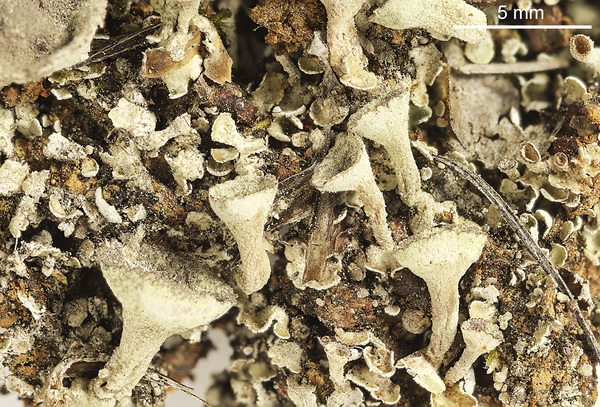Cladonia humilis (With.) J.R. Laundon
Lichenologist, 16: 220, 1984. Basionym: Lichen humilis With. - Bot. Arrang. Veget. Gr. Br., 2: 721, 1776.
Synonyms: Cladonia conoidea Ahti
Distribution: N - Ven, Lomb (Gheza 2015), Piem (Gheza 2015), Lig (Gheza & al. 2020). C - Tosc (Burgaz & al. 2020), Laz (Gigante & Petriccione 1995), Abr (Gheza & al. 2021), Mol (Garofalo & al. 1999, Caporale & al. 2008), Sar (Zedda 2002, Burgaz & al. 2020). S - Camp (Garofalo & al. 1999), Pugl, Cal (Puntillo 1996, Burgaz & al. 202), Si (Merlo 2004, Burgaz & al. 2019, 2020).
Description: Primary thallus squamulose, persistent, the squamules 3-10 mm long, 1-3 mm wide, rounded to sparingly incised, white and often slightly veined beneath, rarely sorediate at margins. Podetia goblet-shaped, hollow inside, greyish-green, corticate only at base, generally esquamulose, 4-11 mm tall, with regular, 3-4(-8) mm wide cups abruptly tapering to a very stalk which is shorter than the diameter of cups (the cups appearing subsessile), continuously and smoothly corticate, finely pruinose from the base to the cups, but farinose-sorediate in upper parts and inside the cups, the soredia 20-60 μm in diam. Apothecia rare, brown, convex, stipitate along the margins of cups. Asci 8-spored, clavate, thickened at apex, with a K/I+ blue tholus and a K/I+ strongly blue outer gelatinous sheath, Cladonia-type. Ascospores 1-celled, hyaline, ellipsoid. Pycnidia dark, ovoid, developing along the margins of cups, with a colourless jelly. Conidia hyaline, curved. Photobiont chlorococcoid. Spot tests and chemistry: four chemotypes (all of them C-, KC-, UV-): 1) K+ yellow, P+ red (atranorin, fumarprotocetraric acid complex), 2) K-, P+ red (bourgeanic and fumarprotocetraric acids), 3) K+ yellow, P+ red (atranorin, fumarprotocetraric and bourgeanic acids), 4) K-, P+ red (fumarprotocetraric acid complex). Chemotype 1) is the most frequent.
Note: a mild-temperate, widespread species found on disturbed, often sandy soil, more rarely on lignum and mossy trees at low elevations; mainly Tyrrhenian in Italy.
Growth form: Fruticose
Substrata: lignum, soil, terricolous mosses, and plant debris
Photobiont: green algae other than Trentepohlia
Reproductive strategy: mainly asexual, by soredia, or soredia-like structures (e.g. blastidia)
Most common in areas with a humid-warm climate (e.g. most of Tyrrenian Italy)
Pioneer species
Commonnes-rarity: (info)
Alpine belt: absent
Subalpine belt: absent
Oromediterranean belt: absent
Montane belt: absent
Submediterranean belt: extremely rare
Padanian area: absent
Humid submediterranean belt: rather rare
Humid mediterranean belt: rare
Dry mediterranean belt: absent

Predictive model
Herbarium samples


Felix Schumm – CC BY-SA 4.0
[10502], Spanien, Kanaren, La Gomera: An der Straße von Arure nach San Sebastian bei der Abzweigung nach Las Hayas, 28°08.280' N, 17°16.916' W, 1115 m, in der Erica-Myrica-Zone. Leg. Schumm 21.04.2003, det. Ahti 2011.


P.L. Nimis; Owner: Department of Life Sciences, University of Trieste
Herbarium: TSB (21647)
2001/12/04


Felix Schumm – CC BY-SA 4.0
[10502], Spanien, Kanaren, La Gomera: An der Straße von Arure nach San Sebastian bei der Abzweigung nach Las Hayas, 28°08.280' N, 17°16.916' W, 1115 m, in der Erica-Myrica-Zone. Leg. Schumm 21.04.2003, det. Ahti 2011.


Felix Schumm – CC BY-SA 4.0
[14013], Portugal, Azoren, Terceira, an der Straßenkreuzung EN3-1 (Angra do Heroismo nach Biscoitos) nach Veredas, Cryptomeria japonica Wald, 38°41.738' N, 27°14.224' W, 400 m. Leg. Schumm 11.07.2008, det. Aptroot 2009


Felix Schumm – CC BY-SA 4.0
[14013], Portugal, Azoren, Terceira, an der Straßenkreuzung EN3-1 (Angra do Heroismo nach Biscoitos) nach Veredas, Cryptomeria japonica Wald, 38°41.738' N, 27°14.224' W, 400 m. Leg. Schumm 11.07.2008, det. Aptroot 2009


Felix Schumm – CC BY-SA 4.0
[14013], Portugal, Azoren, Terceira, an der Straßenkreuzung EN3-1 (Angra do Heroismo nach Biscoitos) nach Veredas, Cryptomeria japonica Wald, 38°41.738' N, 27°14.224' W, 400 m. Leg. Schumm 11.07.2008, det. Aptroot 2009


Felix Schumm – CC BY-SA 4.0
[14013], Portugal, Azoren, Terceira, an der Straßenkreuzung EN3-1 (Angra do Heroismo nach Biscoitos) nach Veredas, Cryptomeria japonica Wald, 38°41.738' N, 27°14.224' W, 400 m. Leg. Schumm 11.07.2008, det. Aptroot 2009


Felix Schumm – CC BY-SA 4.0
[14013], Portugal, Azoren, Terceira, an der Straßenkreuzung EN3-1 (Angra do Heroismo nach Biscoitos) nach Veredas, Cryptomeria japonica Wald, 38°41.738' N, 27°14.224' W, 400 m. Leg. Schumm 11.07.2008, det. Aptroot 2009


Felix Schumm – CC BY-SA 4.0
[10502], Spanien, Kanaren, La Gomera: An der Straße von Arure nach San Sebastian bei der Abzweigung nach Las Hayas, 28°08.280' N, 17°16.916' W, 1115 m, in der Erica-Myrica-Zone. Leg. Schumm 21.04.2003, det. Ahti 2011.,
HPTLC in den Laufmitteln A, B’ und C nach Säurebehandlung bei Tageslicht und 366 nm UV-Langwelle. 1: Start, 4: Position von Norstictinsäure, 7: Position von Atranorin, at: Atranorin, pr: Protocetrarsäure, fpr: Fumarprotocetrarsäure

Bernard Bouffinier - Source: http://www.lichensmaritimes.org/index.php?task=fiche&lichen=226&lang=en
France, Crozon

Bernard Bouffinier - Source: http://www.lichensmaritimes.org/index.php?task=fiche&lichen=226&lang=en
France, Crozon

Bernard Bouffinier - Source: http://www.lichensmaritimes.org/index.php?task=fiche&lichen=226&lang=en
France, Crozon

Bernard Bouffinier - Source: http://www.lichensmaritimes.org/index.php?task=fiche&lichen=226&lang=en
France, Crozon

Bernard Bouffinier - Source: http://www.lichensmaritimes.org/index.php?task=fiche&lichen=226&lang=en
France, Lac du Dren

Bernard Bouffinier - Source: http://www.lichensmaritimes.org/index.php?task=fiche&lichen=226&lang=en
France, Jardin Crozon

Bernard Bouffinier - Source: http://www.lichensmaritimes.org/index.php?task=fiche&lichen=226&lang=en
France, Crozon

Bernard Bouffinier - Source: http://www.lichensmaritimes.org/index.php?task=fiche&lichen=226&lang=en
France, Jardin Crozon

Bernard Bouffinier - Source: http://www.lichensmaritimes.org/index.php?task=fiche&lichen=226&lang=en
France, Jardin Crozon

Bernard Bouffinier - Source: http://www.lichensmaritimes.org/index.php?task=fiche&lichen=226&lang=en
France, Jardin Crozon

Bernard Bouffinier - Source: http://www.lichensmaritimes.org/index.php?task=fiche&lichen=226&lang=en
France, Jardin Crozon
Growth form: Fruticose
Substrata: lignum, soil, terricolous mosses, and plant debris
Photobiont: green algae other than Trentepohlia
Reproductive strategy: mainly asexual, by soredia, or soredia-like structures (e.g. blastidia)
Most common in areas with a humid-warm climate (e.g. most of Tyrrenian Italy)
Pioneer species
Commonnes-rarity: (info)
Alpine belt: absent
Subalpine belt: absent
Oromediterranean belt: absent
Montane belt: absent
Submediterranean belt: extremely rare
Padanian area: absent
Humid submediterranean belt: rather rare
Humid mediterranean belt: rare
Dry mediterranean belt: absent

Predictive model
| Herbarium samples |


Felix Schumm – CC BY-SA 4.0
[10502], Spanien, Kanaren, La Gomera: An der Straße von Arure nach San Sebastian bei der Abzweigung nach Las Hayas, 28°08.280' N, 17°16.916' W, 1115 m, in der Erica-Myrica-Zone. Leg. Schumm 21.04.2003, det. Ahti 2011.


P.L. Nimis; Owner: Department of Life Sciences, University of Trieste
Herbarium: TSB (21647)
2001/12/04


Felix Schumm – CC BY-SA 4.0
[10502], Spanien, Kanaren, La Gomera: An der Straße von Arure nach San Sebastian bei der Abzweigung nach Las Hayas, 28°08.280' N, 17°16.916' W, 1115 m, in der Erica-Myrica-Zone. Leg. Schumm 21.04.2003, det. Ahti 2011.


Felix Schumm – CC BY-SA 4.0
[14013], Portugal, Azoren, Terceira, an der Straßenkreuzung EN3-1 (Angra do Heroismo nach Biscoitos) nach Veredas, Cryptomeria japonica Wald, 38°41.738' N, 27°14.224' W, 400 m. Leg. Schumm 11.07.2008, det. Aptroot 2009


Felix Schumm – CC BY-SA 4.0
[14013], Portugal, Azoren, Terceira, an der Straßenkreuzung EN3-1 (Angra do Heroismo nach Biscoitos) nach Veredas, Cryptomeria japonica Wald, 38°41.738' N, 27°14.224' W, 400 m. Leg. Schumm 11.07.2008, det. Aptroot 2009


Felix Schumm – CC BY-SA 4.0
[14013], Portugal, Azoren, Terceira, an der Straßenkreuzung EN3-1 (Angra do Heroismo nach Biscoitos) nach Veredas, Cryptomeria japonica Wald, 38°41.738' N, 27°14.224' W, 400 m. Leg. Schumm 11.07.2008, det. Aptroot 2009


Felix Schumm – CC BY-SA 4.0
[14013], Portugal, Azoren, Terceira, an der Straßenkreuzung EN3-1 (Angra do Heroismo nach Biscoitos) nach Veredas, Cryptomeria japonica Wald, 38°41.738' N, 27°14.224' W, 400 m. Leg. Schumm 11.07.2008, det. Aptroot 2009


Felix Schumm – CC BY-SA 4.0
[14013], Portugal, Azoren, Terceira, an der Straßenkreuzung EN3-1 (Angra do Heroismo nach Biscoitos) nach Veredas, Cryptomeria japonica Wald, 38°41.738' N, 27°14.224' W, 400 m. Leg. Schumm 11.07.2008, det. Aptroot 2009


Felix Schumm – CC BY-SA 4.0
[10502], Spanien, Kanaren, La Gomera: An der Straße von Arure nach San Sebastian bei der Abzweigung nach Las Hayas, 28°08.280' N, 17°16.916' W, 1115 m, in der Erica-Myrica-Zone. Leg. Schumm 21.04.2003, det. Ahti 2011.,
HPTLC in den Laufmitteln A, B’ und C nach Säurebehandlung bei Tageslicht und 366 nm UV-Langwelle. 1: Start, 4: Position von Norstictinsäure, 7: Position von Atranorin, at: Atranorin, pr: Protocetrarsäure, fpr: Fumarprotocetrarsäure

Bernard Bouffinier - Source: http://www.lichensmaritimes.org/index.php?task=fiche&lichen=226&lang=en
France, Crozon

Bernard Bouffinier - Source: http://www.lichensmaritimes.org/index.php?task=fiche&lichen=226&lang=en
France, Crozon

Bernard Bouffinier - Source: http://www.lichensmaritimes.org/index.php?task=fiche&lichen=226&lang=en
France, Crozon

Bernard Bouffinier - Source: http://www.lichensmaritimes.org/index.php?task=fiche&lichen=226&lang=en
France, Crozon

Bernard Bouffinier - Source: http://www.lichensmaritimes.org/index.php?task=fiche&lichen=226&lang=en
France, Lac du Dren

Bernard Bouffinier - Source: http://www.lichensmaritimes.org/index.php?task=fiche&lichen=226&lang=en
France, Jardin Crozon

Bernard Bouffinier - Source: http://www.lichensmaritimes.org/index.php?task=fiche&lichen=226&lang=en
France, Crozon

Bernard Bouffinier - Source: http://www.lichensmaritimes.org/index.php?task=fiche&lichen=226&lang=en
France, Jardin Crozon

Bernard Bouffinier - Source: http://www.lichensmaritimes.org/index.php?task=fiche&lichen=226&lang=en
France, Jardin Crozon

Bernard Bouffinier - Source: http://www.lichensmaritimes.org/index.php?task=fiche&lichen=226&lang=en
France, Jardin Crozon

 Index Fungorum
Index Fungorum
 GBIF
GBIF






